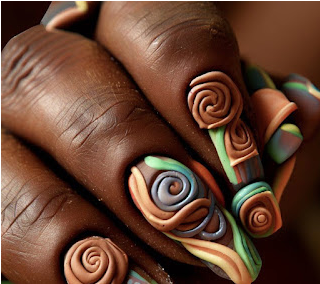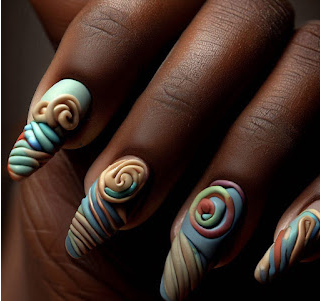
Indigenous nail art practices from Africa include henna, beading, painting and plant and clay ancient African nail art designs.
These manicures are not just nail art; they are living manifestations of a rich African culture painted with threads of heritage, pride, and artistic innovation.
The ingenuity of women shines as they artfully craft stunning nail designs, turning their nails into captivating canvases of beauty.
The mesmerizing world of indigenous nail art in Africa is a historic lesson on getting your nails done in ancient Africa. From the enchanting use of henna in the captivating North African landscapes to the spellbinding beaded nail art that graces the hands of those in East African regions to plant and clay natural nail art from Southern Africa.
Henna or Mehndi Nail Art in North Africa
Henna has been used for centuries in North Africa, particularly in countries like Morocco, Egypt, and Sudan. Intricate designs are created using henna paste, which is applied to the hands and nails. These designs are often symbolic, representing various cultural and spiritual meanings. Henna is still widely practiced today for special occasions and celebrations.
Beaded Nail Art in East Africa
Among the Maasai and Samburu communities of Kenya and Tanzania, nail art involves attaching colorful beads to the nails. This tradition is not only aesthetically pleasing but also carries cultural significance. The colors and patterns of the beads may indicate age, marital status, and even social status within the community.
Ndebele Nail Art in Southern Africa
The Ndebele people of South Africa and Zimbabwe are known for their distinctive geometric art, including nail art. Women in the community paint their nails with bold and colorful patterns, often mirroring the designs found in their beadwork and house paintings. Ndebele nail art is a reflection of cultural pride and identity.
Clay and Plant-Based Nail Decorations in Mali, Southern Africa and Nigeria.
In many African cultures, materials like clay, plant fibers, and natural pigments were used to decorate nails. These materials were not only readily available but also held cultural significance. Nail decorations ranged from simple lines to intricate symbols, each carrying its own meaning within the context of the community.
Dogon People, Mali
The Dogon people of Mali have a tradition of adorning their nails with clay and plant-based materials. They use a mixture of red clay and shea butter to create a paste that is applied to the nails, resulting in a reddish-brown color. This practice is often part of rituals and ceremonies, and the designs vary from simple lines to more elaborate patterns.
Himba People, Namibia
The Himba people of Namibia use a mixture of red ochre and butterfat to create a clay-like paste that is applied to their bodies, including nails. This practice not only serves as a form of decoration but also offers protection against the harsh desert environment. The reddish hue of the paste is considered aesthetically pleasing and symbolizes the Himba’s connection to their land.
San People, Southern Africa
The San people, also known as Bushmen, have historically used plant-based pigments to decorate their bodies, including their nails. These pigments are obtained from various plant sources and are mixed with water to create a paint-like substance. The San people use these natural pigments to create intricate patterns and designs on their nails, adding to their distinctive appearance.
Yoruba People, Nigeria
In Yoruba culture, red clay known as ile ori is used for various body adornments, including nail decoration. The clay is believed to have spiritual significance and is used to connect with ancestral spirits. Yoruba women often create intricate patterns on their nails using this red clay, enhancing their beauty and expressing their cultural identity.
Luba People, Democratic Republic of Congo
The Luba people are known for their artistic traditions, which include body adornment. They use plant-based pigments and natural dyes to create nail decorations as part of their broader body art practices. The designs may vary from community to community, but they often hold symbolic meanings related to status, age, and social roles.
These Ancient African manicures go beyond being mere nail art; they emerge as living embodiments of a lavish tapestry intricately woven with threads of heritage, pride, and ingenious artistic expression.
___
Source here


